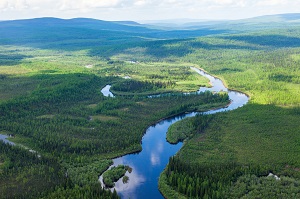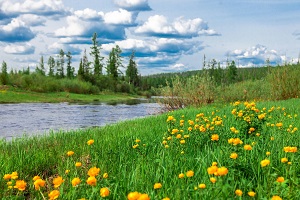Please activate JavaScript in your browser to use all interface options.
Scientists Conduct Vostsibneftegaz-Sponsored Unique Studies of Post-Fire Landscapes of Evenki Forests
01 December 2020
Employees of the Siberian Federal University School of Ecology and Geography jointly with the Sukachev Institute of Forest of the Siberian Branch of the Russian Academy of Sciences have conducted a unique expedition to study post-fire landscapes in Evenki municipal district of Krasnoyarsk Krai as part of a grant project of the East Siberian Oil and Gas Company, a subsidiary of Rosneft Oil Company. Fieldwork took place near the Tura community.
The total area under study was 600,000 km, 25% of which had been subject to forest fires in the last 20 years. The study will help assess the impact of massive natural fires that have become more frequent in Eastern Siberia during the summer period.
The key objective of the study is to forecast the fires and determine the potential for forest restoration. By carrying out a comprehensive analysis of vegetation and soil at test sites, scientists assess the condition of landscapes after a fire. During the expedition, the ecologists collected soil samples, took readings from temperature and humidity sensors, checked the coordinates of the sites under study and measured permafrost under regular forest fires.
 This is the first time that such comprehensive monitoring has been organised in the area. The project has already processed data from ground and remote observations of the post-fire condition of the area under study. Data on the state of vegetation after fires in deciduous forests was obtained by analysing satellite images of the earth and water surface, which show the level of damage and vegetation recovery. Some temperature abnormalities have been recorded in areas disturbed by fires. Moreover, it has been established that the greatest damage to land cover in the extreme conditions of continuous permafrost is caused by stable grassroots fires. They disturb the soil cover, which is the main thermal regulator of the soil environment.
This is the first time that such comprehensive monitoring has been organised in the area. The project has already processed data from ground and remote observations of the post-fire condition of the area under study. Data on the state of vegetation after fires in deciduous forests was obtained by analysing satellite images of the earth and water surface, which show the level of damage and vegetation recovery. Some temperature abnormalities have been recorded in areas disturbed by fires. Moreover, it has been established that the greatest damage to land cover in the extreme conditions of continuous permafrost is caused by stable grassroots fires. They disturb the soil cover, which is the main thermal regulator of the soil environment.
The frequency of forest fires is an urgent issue due to climate change presenting as increased average annual temperatures and decreased precipitation. The fire interval standard is once every 50 years in pine forests and 80 years in deciduous forests. Nowadays, this phenomenon is becoming almost annual, and the forests have no time to recover. According to remote monitoring data, the same areas have started to burn in recent years. Experts believe that unless the necessary measures are taken, there are risks of losing the main wealth of the Siberian taiga--hectares of forest.
Laboratory processing of the data obtained is currently in progress and the material is being analysed and consolidated. The research results will form the basis for assessing the potential of the northern landscapes of the Krasnoyarsk Territory for restoration and will help to develop detailed recommendations for natural resources recovery.
Note for Editors:
The East Siberian Oil and Gas Company, a subsidiary of Rosneft Oil Company, develops the Yurubcheno-Tokhomskoye oil and condensate field in the Evenki district of Krasnoyarsk Territory.
Supporting the culture and traditional way of life of the indigenous people of Evenki is one of the key lines of the social work of the company. During the years of the work in the region, Vostsibneftegaz has implemented a lot of social, charitable and grant programmes.
The Vostsibneftegaz grant scheme has been in operation for the sixth year, and the oil producers have supported over 20 scientific projects such as the Siberian Federal University’s project to study the population of wild reindeer and lesser white-fronted goose listed in Red Book; Central Siberian reserve on research of a population of the Siberian sable, research institute of ecology of fishery reservoirs on working out of biotechnics of artificial reproduction of the Siberian taimen. The Sukachyov Institute of Forest of the Siberian Branch of Russian Academy of Sciences conducted studies of microbiological characteristics of soils of post-fire successions in forest cryogenic ecosystems in Middle Siberia, the Trade and Economics Institute of the Siberian Federal University developed scientific and practical justification for the production of bread for the northerners from Jerusalem artichoke, a perennial herbaceous tuber plant.
The implementation of the grant schemes helps save the unique natural environment, national culture, and traditional way of life and cultural authenticity of indigenous population of Evenki.
Rosneft
Information Division
December 1, 2020

-315xx70.png)

